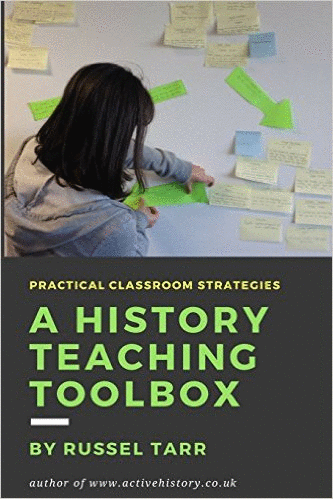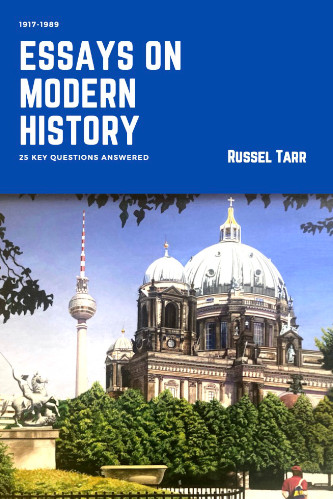World History teaching resources for the high school classroom: lesson plans, worksheets, quizzes and simulation games for KS3, IGCSE, IB and A-Level teachers.
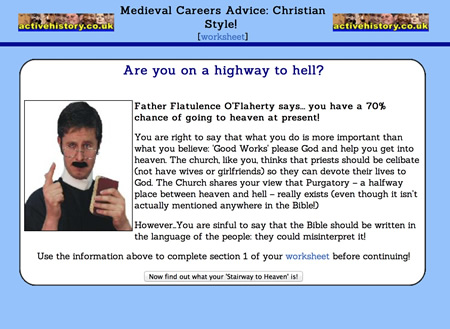 Why was religion so important to people in the Middle Ages?
Why was religion so important to people in the Middle Ages?
In this self-contained unit of study, students are encouraged to see the Church in Medieval terms as a centrure of the community and to see heaven and hell as "real" places which provided medieval people with a framework for life. This helps them to appreciate the importance of the clash between the Crown and Church in the reign of Henry II.
Each of the following three key questions can be approached as separate 'mini-topics' at different points of the year (which is how I approach it myself).
A. Was the Medieval Church loved, or feared?
Why was the Church so important in the Middle Ages?
All to often, students can't quite grasp why the church was so important to medieval people. This lesson is designed to address that issue and engage their interest in the topic through means of a 'timewipe' exercise on the board. There are some samples of student work available from this activity.
What is hell like?
Image sources to share with the class | Prezi of Images
"In this task we will investigate what Medieval people thought Hell was like. In other words, the Church's power was based on FEAR as well as LOVE. The exact balance between these two things is for you to decide later! Your job is to imagine that you are a priest in the Middle Ages. You will produce your own terrifying Medieval sermon warning people about the dangers of hell. To prepare for this, you will be placed into groups. One person from each group should collect a picture from the set of images held by the teacher. They will then answer the four questions in the table overleaf from the rest of the team without showing them the picture. When the discussion is finished and everyone has taken notes, a second person in the team should bring the picture back and get a fresh one. This process will be repeated for as long as the teacher gives you on the activity."
The lesson could begin, or end, with the following short video as a starter or a plenary resource:
What sorts of things could get me into hell? - The Seven Deadly Sins
In this activity students will learn about, and connect, the seven deadly sins. They will also learn about which particular punishments are associated with each of these sins. They will then write a dialogue between two people that can be acted out in front of the class:
a. "The Sinner": You will be going into the Confession Box to tell the Priest all about your sins. You must imagine that you have committed every single one of the deadly sins. You must write a story about yourself in which you will explain to the priest how you committed each of the seven deadly sins. Try to connect these up in a believable story using your answer to question (2) to help you.
b. "The Priest": You will be warning "The Sinner" of the terrible fate that awaits them in hell if they continue sinning in this way. Use the information in the table above, and the work you did in the previous lesson about hell, to help you write this response.
The following dialogue was constructed between one of my American students and myself. We decided to make it a proper fire-and-brimstone affair.
So am I on a Highway to Hell or a Stairway to Heaven?! [Interactive]
In this interactive exercise, students answer a series of questions about their beliefs, hobbies and interests; a Medieval priest (Flatulence O' Flaherty) then tells them what "sins" they are guilty of and - based on their asnwers - what the best way is for them to gain God's forgiveness (e.g. Pilgrim, Monk, Crusader). This activity teaches students about the beliefs and then the practices of the medieval church and comes complete with a worksheet.
End of Unit Project
"Your task is to produce an investigation into the question "Why were people in the Middle Ages so religious?" The opening sentence of each section of your project is provided below. It is up to you how much detail to put in each section. Marks will be awarded for detail, presentation, illustrations and evidence of further research. You may wish to include a cover page as well. The best students will use their classroom notes as a starting point, but will try to find fresh evidence for themselves".
Revision / Consolidation KeyWord Challenge: Medieval Religion [Interactive]
If you are unfamiliar with the format of the game, click here for instructions.
B. How and why were Medieval Cathedrals built?
Medieval Cathedral Building [making use of this slideshow].
This activity gets students to make deductions from original
images to determine how medieval cathedrals were built. They watch a short video to decide what the most horrible job for cathedral builders was (lime burner? stonemason? treadmill operator?) They then investigate the difference between Romanesque and Gothic architecture.
How successfully can you build a Medieval Cathedral? [Interactive]
In this activity, students answer a series of questions asked by King Henry II. Based on the quality of the responses he then decides how likely he is to let them build a cathedral. Complete with a worksheet and a live "leaderboard" to build up a sense of competition!
Gruesome Martryrdoms, Repulsive Relics!
In this activity / presentation (see image), which contains video clips and stimulus images, students are put into teams to research and then present their favoured choice of holy relic to obtain for their new cathedral, and a suitably brave martyr to dedicate the cathedral to.
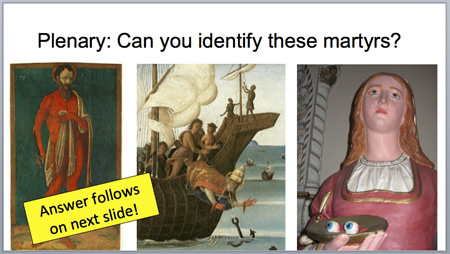
Design your own Cathedral
Students then use their knowledge from the past few activities to design a cathedral of their choice. These might be in the form of drawings, models or computer animations.
Example 1: Minecraft Cathedral designed by Jose:
Example 2: Model Cathedrals by students:
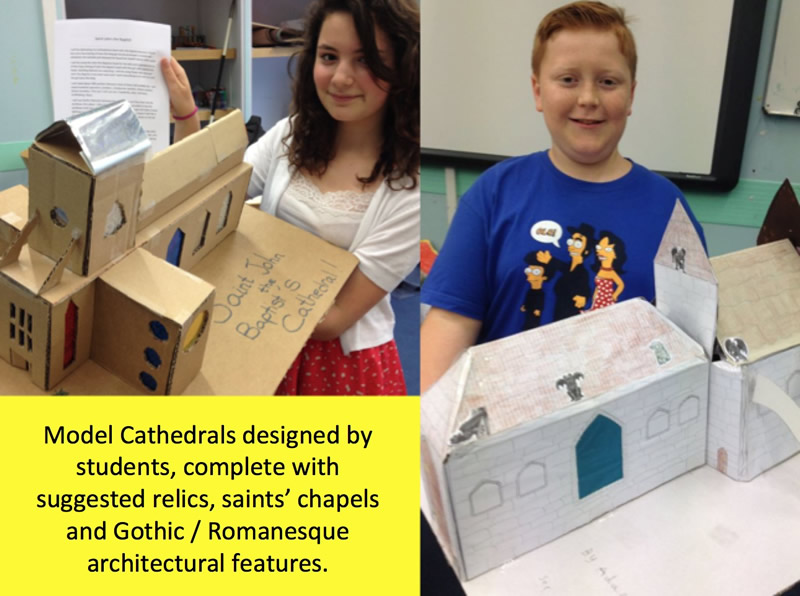
Google Earth Virtual Tours: Five Cathedrals
Students could use the following 3D tours to help them decide upon the design for their own Medieval Cathedral.
The Murder of Becket
Shorter Approach
Why did Henry II and Becket argue?| What happened to Archbishop Becket?
The quarrel between King Henry II of England and Archbishop Thomas Becket of Canterbury is one of the most famous in history. In this investigation you will learn about what the causes and the results of this quarrel were, and form your own opinion about which was the saint and which the sinner. Highlight all the FACTS in the account in one colour, and all the OPINIONS in another. Change each of the opinions so they make Henry sound like a sinner, and Becket a saint. Delete any facts which do not make Becket sound very nice. Compare your finished accounts with a partner, then with the class. Your teacher will read out a sample account when you have all finished.
Longer Approach
ActiveHistory Mystery: Murder in the Cathedral
The "History Mysteries" lessons are designed as stand-alone projects which each last 3-4 hours.
Through engaging historical topics, they teach skills of problem formulation, deductive reasoning, independent research, groupwork and structured writing.
There is a standard teacher lesson plan and student record sheet / markscheme for each activity.

© 1998-2025 Russel Tarr, ActiveHistory.co.uk Limited (Reg. 6111680)
1 Torrin Drive, Shrewsbury, Shropshire, SY3 6AW, England
Privacy Policy | Contact



